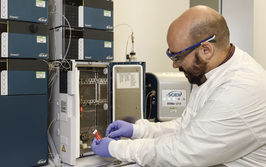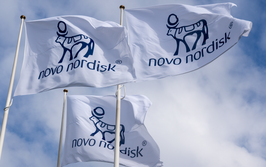Gold and Sugar
A new drug delivery technique could eliminate needles from the vaccination process, as well as help the world prepare for the next pandemic.
| 14 min read | Interview

Coating gold nanoparticles with sugar (carbohydrates) creates a passivation layer to enable them to be seen by the body as organic, rather than as metallic or foreign bodies. These sugars have both hydrophilic (water-attracting) and hydrophobic (water-repelling) sides, which help transition the particles from a metallic to a biological environment. They can then be reduced in size to what Thomas Rademacher, founder and CEO of Gylden Pharma, calls "quantum clusters" or "artificial atoms.” These are clusters of around 100 gold molecules that behave differently – that is, they don’t exhibit the typical properties of gold.
What does this mean for drug development? One primary advantage of these nanoparticles is their potential ability to protect sensitive drugs, such as peptides and RNA, from degradation in the body. The nanoparticles create a protease-resistant field that helps prevent enzymes from breaking down the drugs they carry. Less than 5 nanometers in size, the nanoparticles move through the skin and other biological barriers, and can also be safely excreted. But how do you get them under the skin? Via skin patches, of course. We spoke to Rademacher to find out more.
What validates the use of gold nanoparticles in vaccination technologies?
I cannot emphasize enough the importance of targeting immune responses through the skin, where many immune cells reside, rather than injecting vaccines into muscles.
The nanoparticles are designed to present surface patterns that mimic live pathogens, tricking the immune system into mounting a response similar to what it would generate against a live virus or bacteria. This approach creates a more effective immune response by leveraging the body's pattern-recognition capabilities. The use of microneedle technologies to deliver these nanoparticles, just beneath the surface of the skin, can help them to effectively stimulate the immune system. These particles are designed to evade degradation, penetrate biological barriers, and elicit a strong immune response by mimicking live pathogens. The technology represents a significant advancement in bioengineering, especially for vaccines and precision drug delivery.
What specific diseases are you targeting?
We initially started out with the idea of using microneedle technology on a skin patch to target some of the world’s most dangerous pathogens – those you really don’t want to deal with directly; for example, you wouldn’t want to grow a vat of Ebola or Nipah virus! With these pathogens, you don’t necessarily need the vaccine immediately, but you need to have it stored in a repository, ready to go.
When we first began, we focused on vaccines for diseases that big pharma would never produce because it wouldn’t be economically feasible for them to manufacture millions of doses just to store them indefinitely until there’s demand. When the demand arises, people might also expect the vaccines for free. Big pharma is typically more interested in producing vaccines they can sell regularly, year after year, rather than something they may never sell. So, we started down that path, focusing on vaccines for diseases like Ebola, Marburg, and other dangerous pathogens.
Then, the Zika virus emerged. There is still no vaccine for this. We were lucky that the outbreak eventually disappeared, but it could always return. Zika was particularly challenging because vaccinating the mother is not enough; you have to vaccinate the child in utero. From around 11 or 12 weeks of pregnancy onward, you can potentially vaccinate the child, so we saw our technology as a useful solution if Zika got out of control. We developed a prototype vaccine, but the virus faded away, as these things sometimes do.
Zika, of course, is related to dengue, and dengue is now a major threat affecting about half of the global population. It’s heading towards places such as Florida, Texas, and southern Europe, following the spread of mosquitoes. Initially, people believed there was no need for a new dengue vaccine due to the development of Dengvaxia. However, we predicted that Dengvaxia might not be the most effective and, unfortunately, it was eventually pulled from the market. As a result, the world was left without a dengue vaccine.
These types of live, attenuated vaccines are also difficult to manufacture in large quantities, making it hard to meet the global demand.
Right now, we have arrangements for clinical trials in Switzerland for both SARS (SARS-1 and SARS-2) and dengue. We’re also planning to roll out our dengue vaccine in Brazil and other South American countries, which is critical because of the growing dengue threat. We can also develop flu vaccines for pandemics and avian strains, and we’re working on a range of other vaccines, including for yellow fever, chikungunya, and mpox. Our technology allows us to create vaccines quickly – even synthetic versions of what we call "legacy vaccines." These are vaccines for yellow fever, measles, mumps, polio—all of which are live, attenuated vaccines. While effective, they have their limitations. If we can replace them with something as simple as a patch on the arm that offers the same level of protection then it would be a significant improvement.
Our synthetic vaccines are not merely substitutes, however. They provide the same level of protection as live, attenuated vaccines. In real-world terms, this means long-lasting immunity, similar to the polio vaccine. This long-term protection is based on cellular immunity, which lasts far longer than antibody-based immunity. Many viruses actually thrive on antibodies, using them as part of their virulence mechanism.
In contrast, cellular immunity is more effective at dealing with viruses. Antibodies are great for fighting bacteria, but for viruses that live inside cells, cellular immunity is much more important. Additionally, with this technology, we can eliminate the discomfort of needle pricks and improve vaccination techniques going forward.
What do you think the challenges will be in getting skin patches to the countries and the people that are closest to the threat of diseases such as dengue?
I find it interesting that, despite major issues with diseases like dengue, we don’t see regulatory systems or governments moving any faster than usual. For example, there are huge problems with dengue in the Dominican Republic, Puerto Rico, and other areas, with many people affected. But despite this, governments seem to have other priorities. Dengue is a disease that makes you very sick the first time, but if you get it again, you can develop dengue hemorrhagic fever, which is much more dangerous.
You would think, given these issues, that there would be fast-track mechanisms in place and more funding to address it, but there isn't. Investors, for example, often don’t even know what dengue is. They even sometimes confuse it with something else, such as cancer. So, we’re stuck on the borderline between public health and philanthropy, and moving these things forward really depends on the will of governments. We’ve been very fortunate to work with Brazil, which faces significant challenges with flaviviruses such as dengue. Countries in Southeast Asia also deal with these issues, but at the moment, in the US, you can’t even get a dengue vaccine. The CDC's recommendation is to avoid mosquitoes, which I found to be quite amusing.
I believe vaccines will eventually be administered using patch technology, not injections. There’s no reason for them to be given via needles, especially when the cost of disposing of sharps and needles is often higher than the cost of the vaccine itself. Patch technology will also help address the growing weariness people have toward vaccines, a trend we’ve seen since COVID-19. If people don’t perceive something as life-threatening, they may not willingly get vaccinated for it.
When we travel to Brazil and talk about diseases such as dengue, yellow fever, and Zika, we’re dealing with flaviviruses, a family of viruses that includes 66 different types. So, when someone says they have dengue or Zika, it might be one of many other similar viruses. That’s the brilliance of gold nanoparticle skin patch technology. It can create vaccines for an entire family of viruses. For example, flaviviruses and equine encephalitis are similar enough that our cellular immune system can recognize and react to them.
In Brazil, for instance, if you catch yellow fever, you might also gain some protection against dengue and Zika because these viruses are cross-reactive. That’s a big advantage, especially in areas where it’s hard to know exactly which viruses are circulating. Antibodies, on the other hand, are very specific. You would need 66 different vaccines to cover all the flaviviruses if you were relying solely on antibodies.
As for our progress, we were moving forward quickly, but the COVID-19 pandemic derailed some of our work. Our clinical trials were disrupted, but now we’re getting back on track.
What insights have clinical trials provided so far?
We ran our first human clinical trials in Switzerland because we wanted to work with one of the top regulatory agencies in the world. I have to say, Swissmedic lived up to its reputation! Since this was our first trial, we aimed to do everything by the book. This was the first vaccine trial that exclusively programmed cellular immunity – no antibodies were involved. Additionally, we were essentially programming people for life, instructing their bodies on exactly what to do.
If you receive a live yellow fever vaccine, your body will make some choices on its own, such as whether to create certain types of immunity, and everyone’s response may be different. Even two identical twins might respond differently. But that’s not how our approach works. Our approach directly tells the immune system to make T cells against specific targets. Essentially, it creates an army of T cells specifically designed to combat X, Y, and Z. This approach also allowed us to bypass what’s called "immune imprinting," where the body’s response to a new vaccine is influenced by previous infections. We wanted to vaccinate everyone as though they had no prior history.
We conducted an unusual trial in which we ran two vaccines against each other, instead of just using a placebo: one for dengue and one for SARS. We still had a placebo group, but the idea was to see what the commonalities were in the immune responses to two very different viruses. SARS-CoV-1 is a respiratory virus, while dengue primarily affects the skin. If the immune system reacted similarly to both, it would suggest that we had a platform capable of addressing a broad range of viruses, whether they are inhaled or contracted through the skin. That’s exactly what we found; there were significant commonalities in the immune response to both viruses, and the results were incredibly promising. We achieved everything we set out to do, and it was particularly interesting in the dengue trial. The vaccine should provide immunity for life after just one shot, but we decided to test a second injection. So, we administered one dose in one arm and then three or four weeks later gave another dose in the other arm.
Think of it like this: the second arm acted as a "fake mosquito bite" for the dengue vaccine. You can’t really boost T cell responses, but the second injection tricked the immune system into thinking it was dealing with a new mosquito bite. The T cells that were generated from the first shot homed in on the second injection site, as if it was a real mosquito bite, and the results were fantastic. It worked exactly as we had hoped.
We learned a tremendous amount from that trial, and it has made us very optimistic about the future of this technology.
The Medicine Maker Presents:
Enjoying yourself? There's plenty more where that came from! Our weekly Newsletter brings you the most popular stories as they unfold, chosen by our fantastic Editorial team!
Do you foresee a role to play in pandemic preparedness?
In addition to addressing high-risk groups, we’ve also helped out with what I call "repository issues.” There are a lot of dangerous pathogens out there, and having vaccines ready in a repository is critical. For example, historical data shows an interesting pattern; before every influenza A pandemic, there has been a horse pandemic. This has been happening since the 18th century, almost like clockwork. You see equine flu, and a few months later, an influenza pandemic strikes. Even in 1918, there were suggestions that horses from the trenches during World War I might have played a role. It's a recurring pattern – roughly every 50 years, there’s an influenza pandemic. The last one was in 2009, when the first known case occurred in a little boy named Edgar Hernandez in Perote, Mexico. We know he was the first person to contract the 2009 pandemic flu, but no one knows how he got it. Coincidentally, there was a horse show in the area at the time.
The point is, with our technology, we can think outside the box. Right now, everyone is focused on avian flu, but historically, avian flu has never caused a human pandemic. Instead, there’s more evidence suggesting the role of other animals, like horses. With this technology, we can be prepared ahead of time. We could have a reservoir of horse vaccines ready to go. This kind of preparedness allows us to stay ahead of the game. With this technology, we can literally have vaccines ready on the shelf, waiting to be deployed. We made a SARS-1 vaccine and offered it to governments, suggesting they store it in case the virus reappears, but governments often prefer to wait for a threat to materialize. In many cases, I feel like we’ve taken on the responsibilities of governments. If I were in Singapore or Hong Kong, I would want a stockpile of SARS-1 vaccines stored away in case of an outbreak, but that’s not how things work.
Given the capabilities of our technology, we’ve decided to develop our own internal repository. We’ve created vaccines for some very strange pathogens, and one day, someone might need them. The beauty of this technology is that once we’ve made the vaccine, it’s stable. It can be frozen and stored for long periods, so if an emergency arises, we can have it ready to go within 24 hours. We’ve learned a lot from making these vaccines, and in many ways, we’ve entered the "repository business" ourselves.
The story with Ebola is a perfect example. When the Ebola outbreak happened in 2005, governments poured billions into the development of an Ebola vaccine. Big companies got involved using early technologies with recombinant viruses and other advanced methods. It cost an absolute fortune. Even then, it took about 18 months to prepare something for a phase I trial.
By the time they were ready to test the vaccine, the Ebola outbreak had already subsided. They managed to control the epidemic by sealing borders and implementing public health measures. You need an ongoing epidemic to properly test a vaccine because you can’t ethically expose people to the virus on purpose. This lack of real-world cases essentially killed the development of the Ebola vaccines.
But this led to the idea of preparedness. Our approach is that you need to have the vaccine ready at the time of the outbreak so you can test it while the epidemic is happening. Otherwise, how can you know if it works? You can't intentionally infect people with something like Zika just to test a vaccine.
This concept of preparedness was also supported by initiatives such as the Gates Foundation’s CEPI (Coalition for Epidemic Preparedness Innovations), which had a similar goal, although they've since gone in different directions.
So yes, it all comes down to preparedness. If you don't have the epidemic happening, how can you test the vaccine? People often forget that these viruses are human-specific. They’ll suggest testing a vaccine in animals, but many viruses, like dengue, don’t affect animals the same way. I remember when we were working on dengue, and someone asked, "Have you tested it in monkeys?". Well, monkeys don’t get dengue. These are human viruses. There are viruses specific to cats, for example, that have evolved alongside them, just as these have evolved with humans.
What are your hopes for the future of this technology?
I’m a strong believer in targeted vaccines. Going back to the SARS-CoV-2 and COVID-19 situation, some argued that the world would have been better off if we had only vaccinated people aged 65 and older. In other words, focusing on the populations most at risk. Around 95-98 percent of the severe cases occurred in people over 85. So, I think we need to be realistic about which populations are most important to vaccinate.
Many of the high-risk groups also include young children. For example, with dengue, the most common age children contract it is at around eight months old. At this point, the antibodies they received from their mother begin to decrease, and that’s when they become vulnerable. It’s almost like clockwork – around eight months, give or take a few days. The risk of contracting dengue increases if they are bitten by a mosquito, so we know there are critical windows where vaccines can make a huge impact.
That said, not everyone in Brazil dies from dengue. People build up immunity over their lifetime through exposure to mosquitoes. By the time most people reach 18, the population is usually seropositive for dengue. So, while elimination might not be realistic, there are certain groups for whom vaccines are extremely important.



















